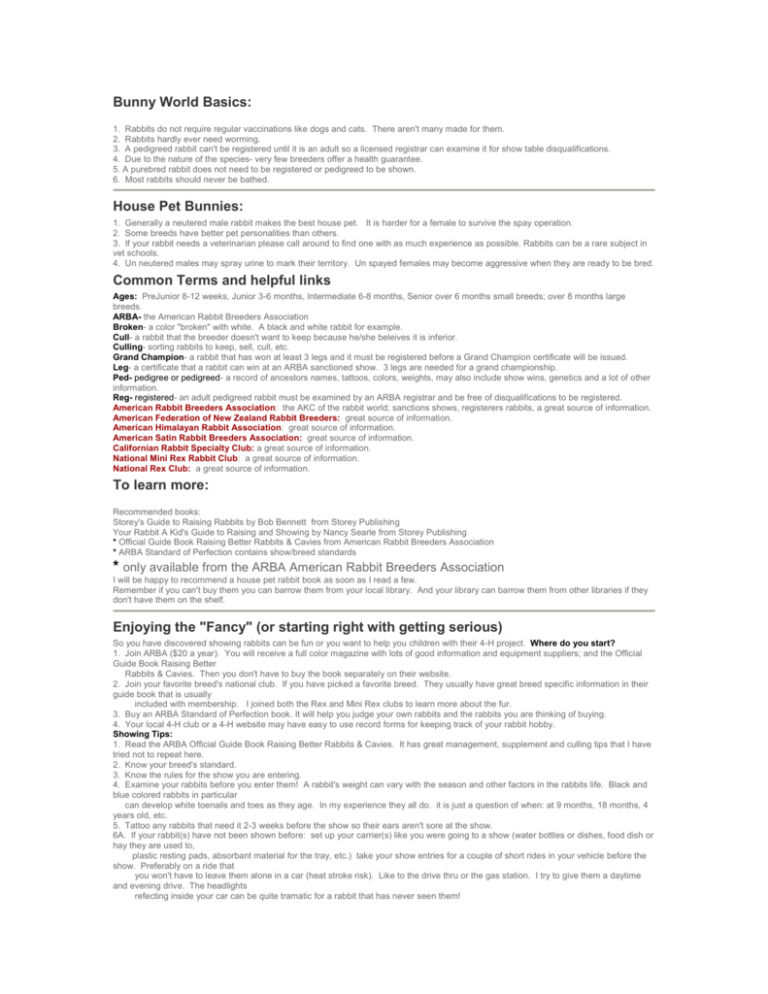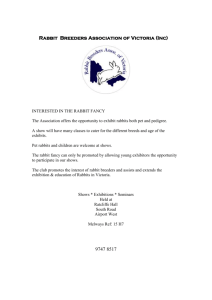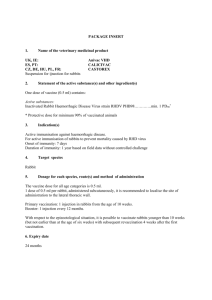Bunny World Basics:
advertisement

Bunny World Basics: 1. Rabbits do not require regular vaccinations like dogs and cats. There aren't many made for them. 2. Rabbits hardly ever need worming. 3. A pedigreed rabbit can't be registered until it is an adult so a licensed registrar can examine it for show table disqualifications. 4. Due to the nature of the species- very few breeders offer a health guarantee. 5. A purebred rabbit does not need to be registered or pedigreed to be shown. 6. Most rabbits should never be bathed. House Pet Bunnies: 1. Generally a neutered male rabbit makes the best house pet. It is harder for a female to survive the spay operation. 2. Some breeds have better pet personalities than others. 3. If your rabbit needs a veterinarian please call around to find one with as much experience as possible. Rabbits can be a rare subject in vet schools. 4. Un neutered males may spray urine to mark their territory. Un spayed females may become aggressive when they are ready to be bred. Common Terms and helpful links Ages: PreJunior 8-12 weeks, Junior 3-6 months, Intermediate 6-8 months, Senior over 6 months small breeds; over 8 months large breeds. ARBA- the American Rabbit Breeders Association Broken- a color "broken" with white. A black and white rabbit for example. Cull- a rabbit that the breeder doesn't want to keep because he/she beleives it is inferior. Culling- sorting rabbits to keep, sell, cull, etc. Grand Champion- a rabbit that has won at least 3 legs and it must be registered before a Grand Champion certificate will be issued. Leg- a certificate that a rabbit can win at an ARBA sanctioned show. 3 legs are needed for a grand championship. Ped- pedigree or pedigreed- a record of ancestors names, tattoos, colors, weights, may also include show wins, genetics and a lot of other information. Reg- registered- an adult pedigreed rabbit must be examined by an ARBA registrar and be free of disqualifications to be registered. American Rabbit Breeders Association: the AKC of the rabbit world; sanctions shows, registerers rabbits, a great source of information. American Federation of New Zealand Rabbit Breeders: great source of information. American Himalayan Rabbit Association: great source of information. American Satin Rabbit Breeders Association: great source of information. Californian Rabbit Specialty Club: a great source of information. National Mini Rex Rabbit Club: a great source of information. National Rex Club: a great source of information. To learn more: Recommended books: Storey's Guide to Raising Rabbits by Bob Bennett from Storey Publishing Your Rabbit A Kid's Guide to Raising and Showing by Nancy Searle from Storey Publishing * Official Guide Book Raising Better Rabbits & Cavies from American Rabbit Breeders Association * ARBA Standard of Perfection contains show/breed standards * only available from the ARBA American Rabbit Breeders Association I will be happy to recommend a house pet rabbit book as soon as I read a few. Remember if you can't buy them you can barrow them from your local library. And your library can barrow them from other libraries if they don't have them on the shelf. Enjoying the "Fancy" (or starting right with getting serious) So you have discovered showing rabbits can be fun or you want to help you children with their 4-H project. Where do you start? 1. Join ARBA ($20 a year). You will receive a full color magazine with lots of good information and equipment suppliers; and the Official Guide Book Raising Better Rabbits & Cavies. Then you don't have to buy the book separately on their website. 2. Join your favorite breed's national club. If you have picked a favorite breed. They usually have great breed specific information in their guide book that is usually included with membership. I joined both the Rex and Mini Rex clubs to learn more about the fur. 3. Buy an ARBA Standard of Perfection book. It will help you judge your own rabbits and the rabbits you are thinking of buying. 4. Your local 4-H club or a 4-H website may have easy to use record forms for keeping track of your rabbit hobby. Showing Tips: 1. Read the ARBA Official Guide Book Raising Better Rabbits & Cavies. It has great management, supplement and culling tips that I have tried not to repeat here. 2. Know your breed's standard. 3. Know the rules for the show you are entering. 4. Examine your rabbits before you enter them! A rabbit's weight can vary with the season and other factors in the rabbits life. Black and blue colored rabbits in particular can develop white toenails and toes as they age. In my experience they all do. it is just a question of when: at 9 months, 18 months, 4 years old, etc. 5. Tattoo any rabbits that need it 2-3 weeks before the show so their ears aren't sore at the show. 6A. If your rabbit(s) have not been shown before: set up your carrier(s) like you were going to a show (water bottles or dishes, food dish or hay they are used to, plastic resting pads, absorbant material for the tray, etc.) take your show entries for a couple of short rides in your vehicle before the show. Preferably on a ride that you won't have to leave them alone in a car (heat stroke risk). Like to the drive thru or the gas station. I try to give them a daytime and evening drive. The headlights refecting inside your car can be quite tramatic for a rabbit that has never seen them! 6B. Remember- a rabbit won't eat or drink while in a carrier unless it is relaxed. A hungry, thirsty rabbit may not look good or behave well on the show table. 6C. Also practice posing them and turning them over at home. Nothing disgruntles a judge more than a rabbit so stressed, frightened or aggressive he can't or doesn't want to handle it! 7. Most rabbits reach their good prime show condition at 5 and 1/2 months of age. Then it is a matter of how long you can keep them in their best condition for shows. Some rabbits will go thru a gangly stage between 12 and 14 or 15 weeks old. They may not show well at all at this age You can plan to breed for rabbits of the best show age for specific shows. Buying Tips: 1. Examine the rabbit you want to buy and compare it to the written breed standard. Compare it to its littermates, parents or other family members if possible. You will get a better idea of what genetics your rabbit may be carrying but displaying. 2. Examine its pedigree. If you ever decide to register this rabbit or get a Grand Champion certificate because it has won 3 legs at shows: the pedigree must show 3 generations with a name or tattoo #, color and weight for each ancestor. A lot of pedigrees are missing weights because it is so easy for a breeder to forget to weight their stock. 3. I never pay pedigreed price for a rabbit if I don't get that pedigree paper at the same time! Most promises of "I will mail it" never happen! I always bring blank pedigree forms with me when I go shopping at a rabbit show or breeder's barn. Understanding Pedigrees: Is it complete with all names or tattoos, colors, and weights? Does it contain colors or weights that you do or do not want in your herd? Is the original breeder's name and address on it? Check the descripton, is it the pedigree for THIS rabbit? Read between the lines: Registered ancestors indicate their own show quality- they would not be registered if they had disqualifications. Legs? Indicate those rabbits were shown and won. Grand Champions? Those rabbits were able to win as seniors (adults). Listed wins? Ask if the seller if those wins were as a junior or senior. Once a rabbit's shoulders develope it is almost done growing in most cases. So a rabbit that won as a senior may not have won as a junoir because it had undeveloped shoulders and other characteristics. If the rabbit won a lot as a junior it may have trouble making senior weight or be on the small side for the breed, because it was almost done growing when it won. Hence what I call a Meat Pen Line vs. a Mature Senior Line. This is how I sort them in my head: Meat Pen Line: a winning junior, will be very well developed including the shoulders (almost done growing). Fur will also be as developed/mature as possible. The young rabbit will also probably be well conditioned with supplements. If a rabbit's body is using supplements to look good instead of growing faster it may be almost done growing. The rabbits in a meat pen should match very well in color, body type and conditioning. They are fequently littermates or very closely related (to have matching body type). Breeding them together will give you a good chance at winning next year. But, they may be small seniors, may not big enough to win legs as an adult or earn a grand championship. But it is possible. Mature Senior Line: rabbits that can win as adults. At least one leg has to be won over the age of 6 months as an Intermediate or Senior. A rabbit really winning as an adult probably did not do well as a junior (or meat pen age) because it wasn't fully developed and its body wasn't ready to condition with supplements. It would be more likely to put those extra vitamins into growth than shiny fur. It is possible for a rabbit to show really well at all ages (they are often small seniors), but it is rare. I find it much easier to keep separate lines for meat pens and champions.





